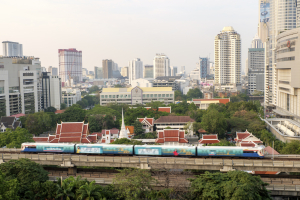Is Urban Renewal Miami’s Next Economic Engine?
 Miami may soon join the ranks of other major U.S. metropolises boasting innovative urban trail projects that have transformed neighborhoods and ignited a firestorm of private investment. The Underline, a proposed development catalyzed by the nonprofit group Friends of the Underline in partnership with Miami-Dade County, will convert the underutilized land below the County’s Metrorail line into a landmark system of urban trails and linear parks integrated with County transit.
Miami may soon join the ranks of other major U.S. metropolises boasting innovative urban trail projects that have transformed neighborhoods and ignited a firestorm of private investment. The Underline, a proposed development catalyzed by the nonprofit group Friends of the Underline in partnership with Miami-Dade County, will convert the underutilized land below the County’s Metrorail line into a landmark system of urban trails and linear parks integrated with County transit.
A look at other comparable projects around the country suggests the Underline may be a powerful economic driver for Miami. New York City’s much-lauded High Line, a roughly 1.5-mile elevated linear park built on an unused portion of the New York Central Railroad, draws nearly five million visitors each year and has spurred $2 billion in adjacent real estate development. In Atlanta, the transformation of a 22-mile historic rail corridor into linear parks and multi-use trails known as the Beltline has generated $2.4 billion in private development.
The project may also have less obvious economic effects, such as attracting and retaining young talent in Miami. Millennials place a high premium on connected, transit-oriented communities that offer a sense of place and alternatives to hours spent crawling in traffic. The Underline can help take Miami off the list of the nation’s deadliest cities for pedestrians and put it on the map as a livable, vibrant destination for young professionals.
The County is poised to play a key role in fueling private development along the corridor through joint development projects and the creation of public-private partnerships (“P3s”). In 1978, the County designated the land below and immediately adjacent to the Metrorail line the “Rapid Transit Zone” (“RTZ”) and equipped the RTZ with a set of development standards aimed at promoting higher density along the rail line and incentivizing private revenue streams. Miami-Dade Transit exercised the RTZ guidelines in the late 1990s, issuing a request for proposals that offered nine Metrorail stations for joint development. The Underline may spark a similar round of invitations to the private sector.
This type of project is also likely to propel the creation of P3s. In addition to partnerships for the development of government-owned land near the Metrorail, the County may also solicit partners for construction and maintenance services as the Underline project moves forward. The Georgia General Assembly passed a bill last month that would allow P3s to finance and build a slew of projects along the Beltline in order to expedite adjacent redevelopment. Florida is one step ahead with progressive P3 legislation already in place.
As the last slivers of Miami’s waterfront properties are developed, the Underline may prove to be the region’s next hot corridor for private investment. Developers and business owners are sure to capitalize on what promises to be a world-class amenity in our community.
